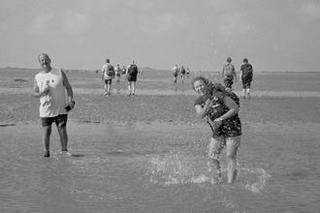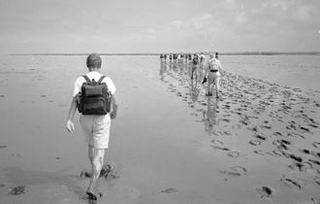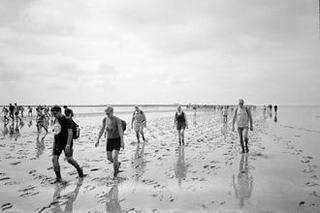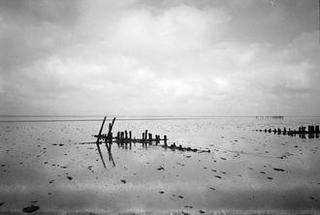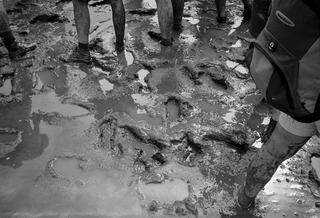Camera Life 4

Nothing could have prepared me for the intense heat and humidity of Houston, Texas, in the late summer of 1984, when I arrived there for my first overseas posting. Even the TV weather forecasts couldn’t cope when screen weather tickers topped out at 99% humidity for the simple reason that they couldn’t handle the three digits required to display 100%.
Graduating from college in 1983, I spent the summer months working in a Hi-fi shop in Glasgow while I looked for a full-time job. I found that job in the autumn and started my training a few weeks before Christmas. Very early on, I learned that the job would entail a lot of overseas travel and that I would be spending a lot of time at sea. It seemed that traveling light would be the order of the day and I wouldn’t be able to take my SLR and lenses with me on my trips. A smaller camera was required.
My 21st birthday was in February 1984, so I asked my sister and brother-in-law for a new camera as a birthday gift. The camera that I chose was the very compact and entirely pocketable Olympus XA. I could write hundreds of words about this camera but Casual Photo File does a much better job than I could and I’m not trying to write about cameras per se.
The XA became my carry-everywhere camera for the next fifteen years or so. Right up until I bought my first digital camera in the late nineties. Even since that time I have still run the occasional roll of film through it.
My job was with a company called Racal Survey, although, in many parts of the world, it was still known by its more historically famous name Decca Survey. As an aside Decca Survey was a separate company from Decca Records, the company that infamously rejected The Beatles. Decca Survey was more famous as the company built out of the technological advances in navigation made during World War Two that enabled the thousand bomber raids over Germany by using its accurate (for the time) navigation network.
After several training courses in the UK and a couple of offshore jobs in the North Sea, I was ready for my first overseas posting, Houston, Texas.
Steamy as Houston was, it was nothing compared to the location for my first assignment of that trip. After a week in the office acclimatizing, I was given a pickup truck and sent to look after a system monitoring station on the gulf coast of Louisiana.  The station itself consisted of a 10 m antenna erected at the edge of a small trailer park some ten miles off the main road and a mile or two from the coast. The monitoring equipment was housed in one of the trailers. It turned out that this was where I too was to be housed for the next three weeks. Whoa, three years of study and, a year after graduation, I’m living in a trailer park in rural Louisiana. That was unexpected.
The station itself consisted of a 10 m antenna erected at the edge of a small trailer park some ten miles off the main road and a mile or two from the coast. The monitoring equipment was housed in one of the trailers. It turned out that this was where I too was to be housed for the next three weeks. Whoa, three years of study and, a year after graduation, I’m living in a trailer park in rural Louisiana. That was unexpected.
Life in the trailer park was “interesting”. I soon learned to be careful when putting the trash out as some small black slithery, almost certainly venomous, wildlife liked to hide in the shade under the bin. I was glad to see that they were just as worried about me as I was about them as they disappeared with some speed when exposed. 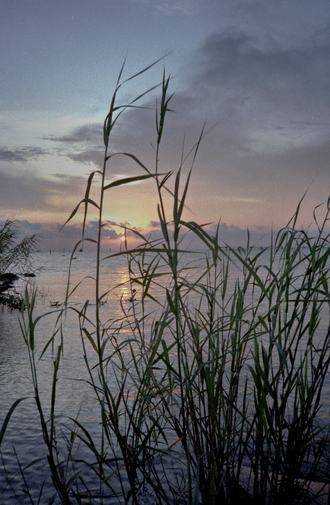 Every evening in the dusk, I was entertained by a light show from thousands of fireflies at the edge of the nearby wood. My neighbors told me that there were alligators in the area too although I never managed to see any, even after making a couple of special trips to the places where they were supposed to hang out. I did see a few later in the trip when I had to over-fly the region in a helicopter.
Every evening in the dusk, I was entertained by a light show from thousands of fireflies at the edge of the nearby wood. My neighbors told me that there were alligators in the area too although I never managed to see any, even after making a couple of special trips to the places where they were supposed to hang out. I did see a few later in the trip when I had to over-fly the region in a helicopter.
I was also entertained by my trailer park neighbor, Lionel (“Lah’own’eyll”) and his timid wife, Dolly. In the politically incorrect words (even then) of my Texan colleagues, Lionel was a “coon-ass”, the Louisiana equivalent of a “red-neck” in Texas. Basically, he was poor, white, and rural. He was a big man, best described as the human equivalent in stature and speech of Foghorn Leghorn the Looney Tunes cartoon rooster.
Lionel, it turned out, liked to do odd jobs and, according to Lionel, my predecessors always paid him $20 to cut the grass around the antenna. I’m not sure if that was entirely true, but I was happy enough to give him the work because it was a large area and the days were hot. This paid off as Lionel then offered to introduce me to the local speciality, gumbo, “dat’s good eat’n boy, good eat’n” is how I remember him describing it to me. What he omitted to explain was that he was going to cook this crab gumbo (an all-day affair) in my trailer, on my stove, using my gas. I think I ended up paying for the crabs as well. No matter, it was good eat’n.
I have several more stories from this period maybe I’ll revisit it in a future post.
Perhaps my last successful outing with the Olympus XA was almost twenty years later in the Netherlands. Long after leaving Racal, I was working on a publishing project in Amsterdam. A dutch friend invited me to join her on a peculiarly dutch activity called wadlopen. On certain days (preferably warm sunny summer days) at low tide, large groups of walkers take to the mud along the north coast of Fryslân and walk across the mudflats to one of the islands that lie a few kilometers off the coast. It’s decidedly muddy and, at times, extremely wet as on some stretches walkers are chest-deep in the sea.
No way was I going to take my shiny new DSLR on a risky trip like that. So, out came the trusty XA and a few rolls of black and white film. It took most of the day, but we made it to the island of Ameland, tired, wet, and very salty, but not too muddy because the deeper channel had washed the worst off. Then we had to dash back to the main town on the island to catch the ferry back to the mainland. Wadlopen was a lot more fun than it sounds. A few hours later, back in my apartment in Amsterdam I headed straight into a much-needed shower and immediately tripped getting in, breaking my toe. Such is life.
My absolute last outing with the XA was on a photo-walk in Shanghai in 2016. I took the XA and my Fujifilm X100T. During the walk, it was clear that the rangefinder window was misaligned, so I couldn’t trust the focus. I’ve yet to process those films (that’s them in the photo at the top of this post).
I’ll finish with a few photos of wadlopen in the Netherlands. All the best!
